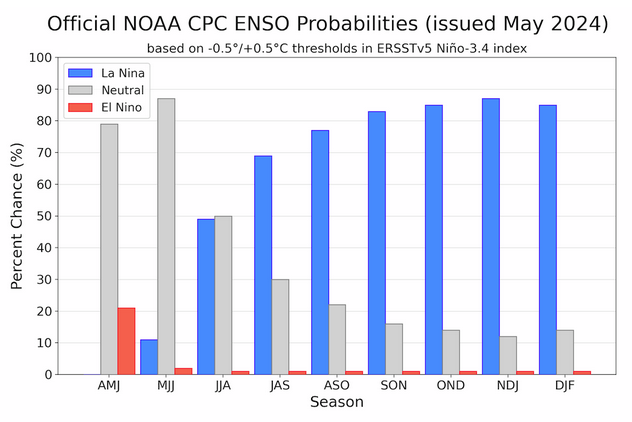On the second Thursday of every month, NOAA (really their Climate Prediction Center CPC) issues its analysis of the status of ENSO. This includes determining the Alert System Status. NOAA again describes their conclusion as “ENSO Alert System Status: El Nino Advisory La Nino Watch”
The exact timing of the transition is not very clear which will impact the reliability of the Seasonal Outlook to be issued next Thursday. It does look like the onset may be slightly slower than thought last month. This may turn out to be a trend i.e. recognizing that the onset will be less rapid than previously thought. I am just guessing. It is difficult to predict how the phases of ENSO will unfold.
We have included an ENSO Blog article by Emily Becker.
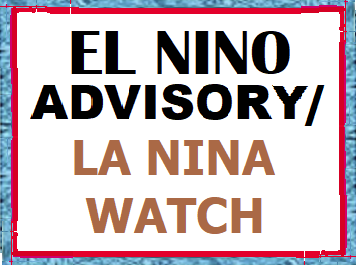 >
>
CLIMATE PREDICTION CENTER ENSO DISCUSSION
| The second paragraph is what is important:
“The most recent IRI plume favors an imminent transition to ENSO-neutral, with La Niña developing during July-September 2024 and then persisting through the Northern Hemisphere winter. The forecast team continues to favor the dynamical model guidance, which suggests La Niña could form as early as June-August 2024, with higher confidence of La Niña during the following seasons. La Niña generally tends to follow strong El Niño events, which also provides added confidence in the model guidance favoring La Niña. In summary, a transition from El Niño to ENSO-neutral is likely in the next month. La Niña may develop in June-August (49% chance) or July-September (69% chance).” Below is the middle paragraph from the discussion last month. “The most recent IRI plume indicates a transition to ENSO-neutral during spring 2024, with La Niña potentially developing during late summer 2024. The forecast team continues to favor the dynamical model guidance, which is slightly more accurate than statistical models during this time of year. La Niña tends to follow strong El Niño events, which also provides added confidence in the model guidance favoring La Niña. In summary, a transition from El Niño to ENSO-neutral is likely by April-June 2024 (85% chance), with the odds of La Niña developing by June-August 2024 (60% chance).” |
We now provide additional details.
CPC Probability Distribution
Here are the new forecast probabilities. The probabilities are for three-month periods e.g. MAM stands for March/April/May.
Here is the current release of the probabilities:
| This chart shows the forecasted progression of the evolution of ENSO from the current El Nino State to Neutral and by the summer to La Nina. This kind of bar chart is not very good at showing uncertainty. |
Here is the forecast from last month.
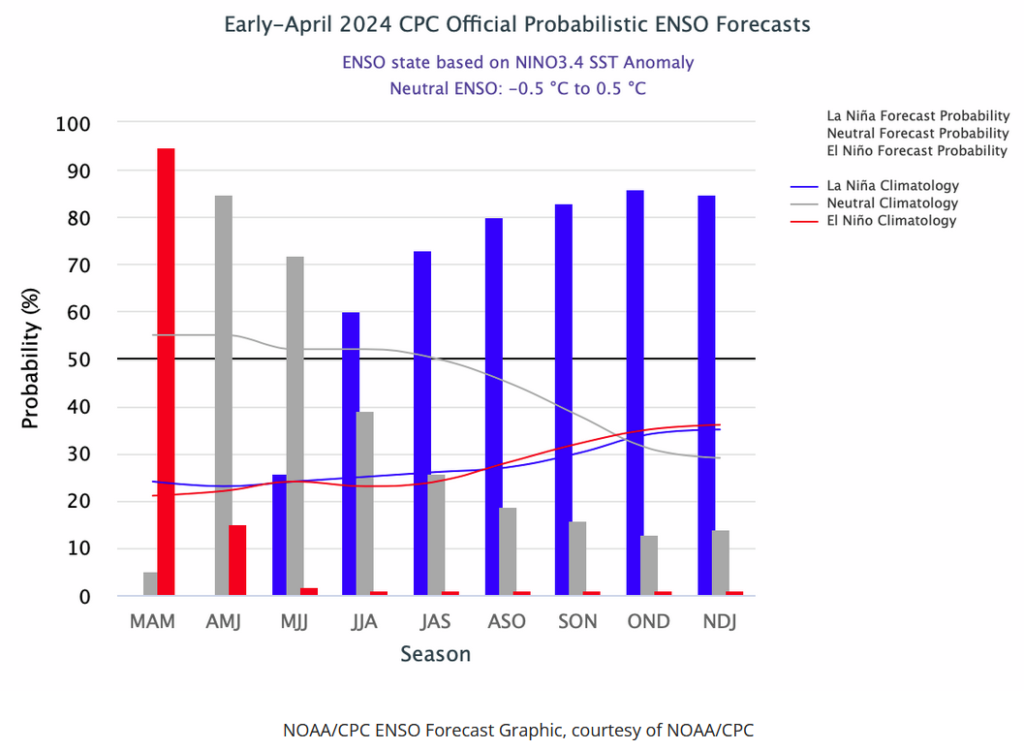
| The analysis this month and last month are not very different. |
What Does the NOAA Proprietary ENSO Model Forecast?

| Notice the wide spread of the solutions. If you want to see an updated version you can view an updated version by clicking HERE. This is not the official CPC forecast but a secondary tool that they use. It shows a fairly strong La Nina coming. |
View of other Models.
| There is disagreement on this La Nina and the disagreement is geographically oriented. The Asian forecasters are less convinced of a La Nina coming as soon as NOAA predicts. |
I do not yet have the JAMSTEC forecasts.
Looking at Actual Current Conditions.
NOAA reports some derived data that describes the current situation and a forecast. But what if we want to form our own opinion? After all, meteorologists are looking at the actual current situation and making predictions.
This shows the current actual situation for the surface of oceans. To update this graphic click HERE.

| You can no longer see the warm tongue of water extending from Ecuador and Peru. It has been replaced by a cold tongue. The warm anomaly is increasingly separating from South America and it is not colored very dark red. It has some Modoki characteristics. We are discussing ENSO tonight but you can see a lot of interesting things here. It is only a one-day snapshot so keep that in mind. There is not much warm water along any coast of the United States. The situation for South America and the Western Caribbean is different. |
Putting the historical information in motion. Updates can be found HERE. but should not be needed.
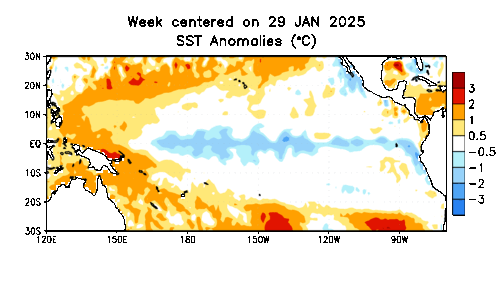
Now we look at the below surface temperature anomalies. Mapping the details. (Cross-Section along the Equator). The data is a five-day average centered on the date shown.
Here is the new map followed by the prior two months to show the progression. The undercutting of the warm water by the cooler water is clear but when does it reach the surface?


| There is not a lot of warm water on the surface and an increasing amount of cooler water below it. The Indo-Pacific Warm Pool is pretty much spent. El Nino’s days are numbered but the timing is not clear but very soon. You can see the evolution of the situation by looking up from the last image in the series to the current one. |
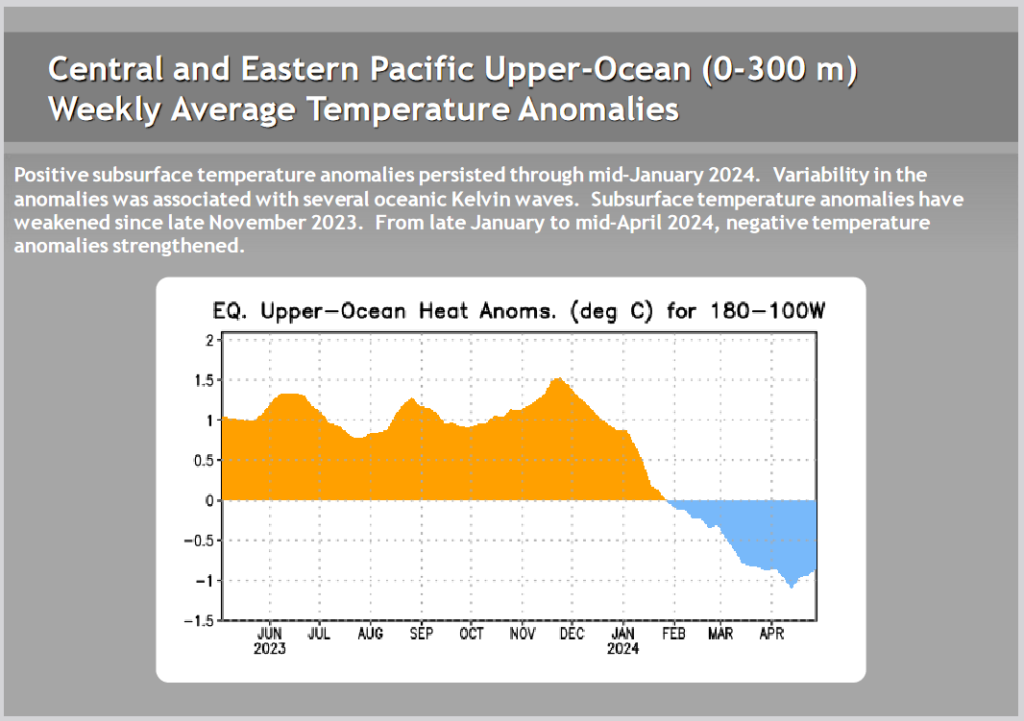
| This shows the water column anomaly is now negative i.e. the warmer water near the surface is dominated by the cooler water below. |
Kelvin Waves
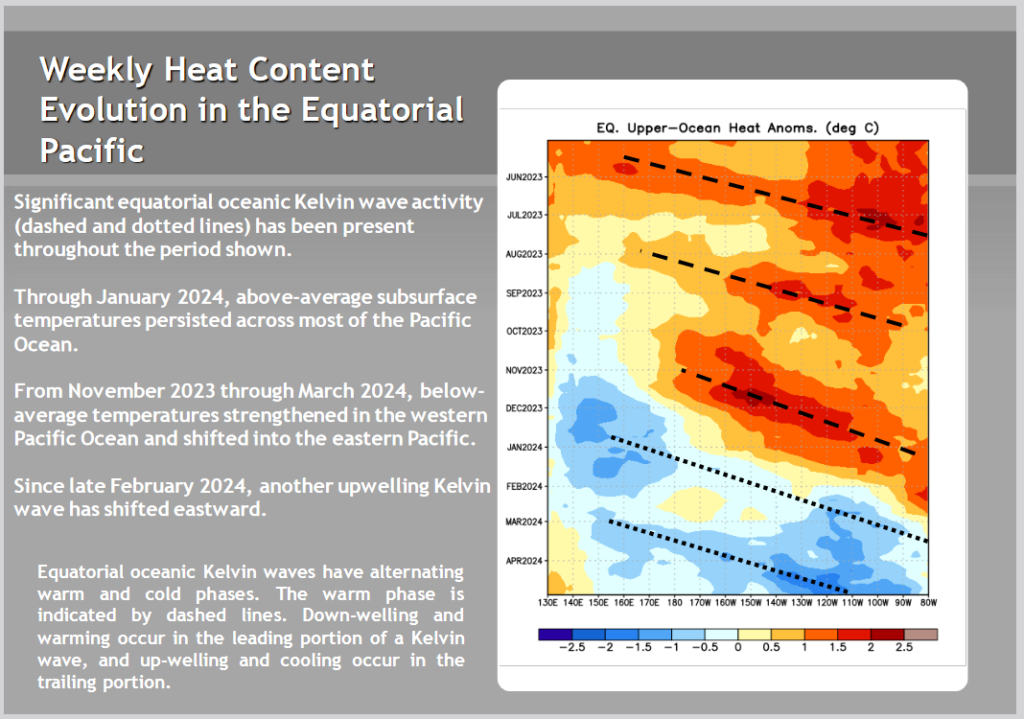
Another Kelvin Wave would maintain or increase the Nino 3.4 Index at least in the short term. But what we see is just the cool upwelling of the prior two Kelvin Waves without a downwelling phase between the two of them. Two upwelling waves in a run. Interesting. |
Is the response of the atmosphere sufficient to sustain an El Nino? This made me want to take a look at the SOI Index, Here is the link to the NOAA version of that graph. They are the same.

| The SOI is now solidly in ENSO Neutral territory. This is covered in the CPC discussion. One wonders if there are any residual impacts of the El Nino once the connection to the atmosphere goes away. |
Now we present the recent ENSO Blog Post by Emily Becker.


| You may not be able to see the various years as it was pretty faint. But this El Nino which is now fading out fit pretty much in the middle of the recent strong El Ninos. The decline may be slightly slower than the mean. |

| You can see that El Nino seems to have caused Africa to have drought. The flood may have been caused by the El Nino but it more likely was caused by the IOD. |
| I hope you found this article interesting and useful. |

